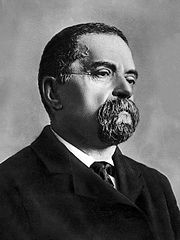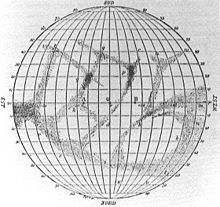Giovanni Schiaparelli
Giovanni Schiaparelli | |
|---|---|
 Giovanni Schiaparelli | |
| Born | Giovanni Virginio Schiaparelli 14 March 1835 |
| Died | 4 July 1910 (aged 75) |
| Nationality | Italian |
| Scientific career | |
| Fields | Astronomy |
Giovanni Virginio Schiaparelli
Biography
He studied at the
Mars

Among Schiaparelli's contributions are his telescopic observations of Mars. In his initial observations, he named the "seas" and "continents" of Mars. During the planet's "great opposition" of 1877, he observed a dense network of linear structures on the surface of Mars, which he called canali in Italian, meaning "channels", but the term was mistranslated into English as "canals".[5]
While the term "canals" indicates an artificial construction, the term "channels"
Later, with notable thanks to the observations of the Italian astronomer
In his book Life on Mars, Schiaparelli wrote: "Rather than true channels in a form familiar to us, we must imagine depressions in the soil that are not very deep, extended in a straight direction for thousands of miles, over a width of 100, 200 kilometres and maybe more. I have already pointed out that, in the absence of rain on Mars, these channels are probably the main mechanism by which the water (and with it organic life) can spread on the dry surface of the planet."
Astronomy and history of science

| 69 Hesperia | 29 April 1861 | MPC |
An observer of objects in the
Schiaparelli was a scholar of the history of classical astronomy. He was the first to realize that the concentric spheres of Eudoxus of Cnidus and Callippus, unlike those used by many astronomers of later times, were not to be taken as material objects, but only as part of an algorithm similar to the modern Fourier series.[citation needed]
He was elected to the American Philosophical Society in 1901.[10]
Honors and awards
Awards
- Lalande Prize (1868)
- Gold Medal of the Royal Astronomical Society (1872)
- Bruce Medal (1902)
Named after him
- The main-belt asteroid M.P.C. 15090).[11]
- The lunar crater Schiaparelli[8]
- The Martian crater Schiaparelli[8]
- Schiaparelli Dorsum on Mercury[12]
- The 2016 Schiaparelli lander.[13]
Relatives
His niece, Elsa Schiaparelli, became a noted designer or maker of haute couture.[14]
Selected writings
- Sulla determinazione della posizione geografica dei luoghi per mezzo di osservazioni astronomiche (in Italian). Milano. 1872.
{{cite book}}: CS1 maint: location missing publisher (link) - 1873 – Le stelle cadenti (The Falling Stars)
- Osservazioni sulle stelle doppie (in Italian). Milano: Hoepli. 1888.
- Sulla distribuzione apparente delle stelle visibili ad occhio nudo (in Italian). Milano: Hoepli. 1889. Bibcode:1889sdas.book.....S.
- 1893 – La vita sul pianeta Marte (Life on Mars)
- 1925 – Scritti sulla storia della astronomia antica (Writings on the History of Classical Astronomy) in three volumes. Bologna. Reprint: Milano, Mimesis, 1997.
References
- ^ Senato Website
- ^ "Schiaparelli, Giovanni Virginio". Lexico UK English Dictionary. Oxford University Press.[dead link]
- ^ a b "Schiaparelli". The American Heritage Dictionary of the English Language (5th ed.). HarperCollins. Retrieved 5 August 2019.
- ^ "Schiaparelli". Merriam-Webster.com Dictionary. Retrieved 5 August 2019.
- ^ a b Washam, Erik, "Cosmic Errors: Martians Build Canals!", Smithsonian magazine, December 2010.
- ^ "Minor Planet Discoverers (by number)". Minor Planet Center. 23 May 2016. Retrieved 20 June 2016.
- ISBN 978-3-540-00238-3.
- ^ ISBN 978-3-540-00238-3.
- Bibcode:1988JBAA...98..146D.
- ^ "APS Member History". search.amphilsoc.org. Retrieved 19 May 2021.
- ^ "MPC/MPO/MPS Archive". Minor Planet Center. Retrieved 4 July 2016.
- ^ "Schiaparelli Dorsum". Gazetteer of Planetary Nomenclature, International Astronomical Union (IAU) Working Group for Planetary System Nomenclature (WGPSN).
- ^ Patterson, Sean (8 November 2013). "ESA Names ExoMars Lander 'Schiaparelli'". Space Fellowship. Retrieved 8 November 2013.
- ^ "ELSA SCHIAPARELLI". Vogue. Archived from the original on 7 August 2014. Retrieved 17 December 2014.
Further reading
- Chisholm, Hugh, ed. (1911). . Encyclopædia Britannica. Vol. 24 (11th ed.). Cambridge University Press. pp. 322–323.
- "Schiaparelli, Giovanni Virginio (1835–1910)", biography from www.daviddarling.info.
- Obituaries: G. V. Schiaparelli, J. G. Galle, J. B. N. Hennessey J. Coles, J. E. Gore, The Observatory, Vol. 33, p. 311–318, August 1910
External links
 Source texts from Wikisource in Italian and English.
Source texts from Wikisource in Italian and English.- Le Mani su Marte: I diari di G.V. Schiaparelli. Observational diaries, manuscripts & drawings. Historical Archive of Brera Observatory. (in Italian)
- Works by Giovanni Virginio Schiaparelli at Project Gutenberg
- Works by or about Giovanni Schiaparelli at Internet Archive
